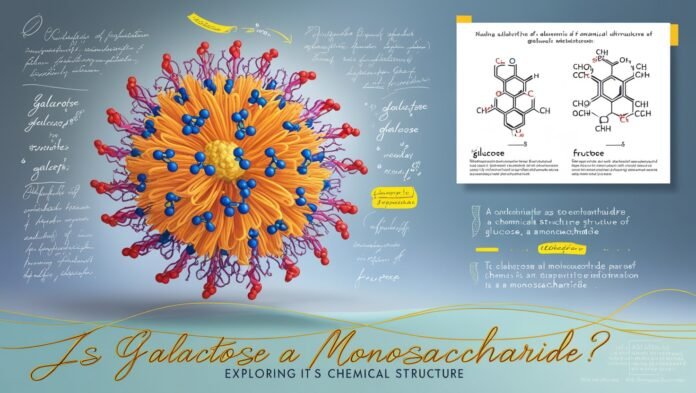Introduction:
In the study of carbohydrates and sugars, an important question frequently comes up: Is galactose a monosaccharide? To comprehend this, it is necessary to begin by exploring the world of carbohydrates and discover the nature of monosaccharides. This article will help answer the question and will take an in-depth look at the chemical structure of galactose, a sugar that is more important in our biology.
What Is a Monosaccharide?
The first thing to consider is: What is a monosaccharide? Before finding out if galactose is actually a monosaccharide, an explanation of what a monosaccharide is is to be determined. Monosaccharides comprise carbohydrates at their simplest. The hydrolysis process does not simplify these sugars. Monosaccharides include fructose, glucose, and galactose. These molecules have one sugar unit and are used to make polysaccharides and disaccharides.
The formula of the majority of monosaccharides is C6H12O6; however, the structure and the way the atoms are placed differ. The arrangement of molecules determines whether monosaccharides are ketoses or aldoses. Aldoses possess an aldehyde ring (CHO) within their structure, while ketoses possess the part of a ketone structure. (C=O) within their structures.
Is Galactose a Monosaccharide?
Once we know the nature of monosaccharides, we can focus our attention on glucose. The simplest answer to the question, Is Galactose a Monosaccharide? will be yes. Galactose, in fact, is a monosaccharide. It is a form of sugar that belongs to that category called “simple sugars. Galactose can be found in dairy products. It is a part of lactose. This is a disaccharide composed of one glucose molecule and one galactose molecule.
The galactose structure is quite similar to glucose but with some key distinctions. Both galactose and glucose are hexoses, which means they are both six-carbon sugars. Their molecular arrangement is different, which results in different properties as well as functions within the body.
The Chemical Structure of Galactose
Galactose is a monosaccharide and is made up of carbon (C) and hydrogen (H), as well as oxygen (O) molecules. Its chemical formula is C6H12O6, similar to fructose and glucose; however, the arrangement of atoms differs. The molecule is composed of six carbon atoms, 12 hydrogen atoms, as well as the oxygen molecules.
Galactose is found in two different forms: the aldehyde (open-chain) form as well as the circular (ring) type. In its open-chain variant, galactose is characterized by an aldehyde group located at the one end of the molecules. The aldehyde molecule gives galactose some chemical reaction. In its cyclic version, galactose is a ring when the carbon 5 hydroxyl group is reacted with an aldehyde molecule on carbon 1.If galactose is a component of a disaccharide such as lactose, it’s usually present in its cyclic form because the ring structure lets it bond with other sugars.
Galactose and Its Role in the Body
While the primary concern is: Galactose is a Monosaccharide? It is also crucial to understand the reasons why this sugar is important within biological processes. Galactose plays an important role in many biological processes.
- Galactose: A component of lactose, is one of two monosaccharides that make up lactose. It is the sugar present in milk. After digestion of milk, the enzyme lactase is able to break down lactose into galactose and glucose that can be taken into the human body.
- Cell structure: Galactose is also part of a larger group of complex carbohydrates that play a role in the cell’s structure. For instance, galactose is one of the glycoproteins and glycolipids that are found inside cell membranes. These molecules are essential in cell recognition and communication.
- Energy Production: Once galactose is absorbed by the body, it converts it into glucose, which can be utilized for energy. This process occurs in the liver by several biochemical processes.
Key Differences Between Galactose and Other Monosaccharides
To explore further Galactose is one of the monosaccharides; it is crucial to evaluate it against other monosaccharides with a long history. The most well-known monosaccharides are fructose, glucose, and galactose. While they all have the identical molecular formula (C6H12O6), their structure and function vary.
- Galactose is a hexose-based sugar; however, its chemical structure is different. The main distinction is the location of the carbon-4 hydroxyl group. In glucose, the hydroxyl group is placed downward in the cyclic form; however, in galactose, it is placed upwards. This minor difference makes each sugar unique in its characteristics.
- Fructose: Fructose, on the contrary, is a ketose; that is, it has a ketose group (C=O) instead of an aldehyde group as galactose and glucose. Fructose is a common ingredient in fruits. It is processed differently than galactose and glucose.
Conclusion
So, is galactose a monosaccharide? Yes, it is! Galactose is a simple sugar that is a monosaccharide and is a key component in the biological process. It shares many characteristics with glucose; however, its distinct chemical structure provides it with distinct characteristics and uses. As a part of lactose found in dairy items or as an essential structural component in complex carbohydrates, galactose is vital for the production of energy and structure in cells in general health. Knowing the structure and chemical makeup of galactose as well as its interactions with other sugars can help us comprehend its function in biochemistry as well as our daily diet.
In short, galactose is a monosaccharide essential for our diet as well as our biology, thereby answering the question of whether or not galactose is a monosaccharide with the certainty of “yes.”


